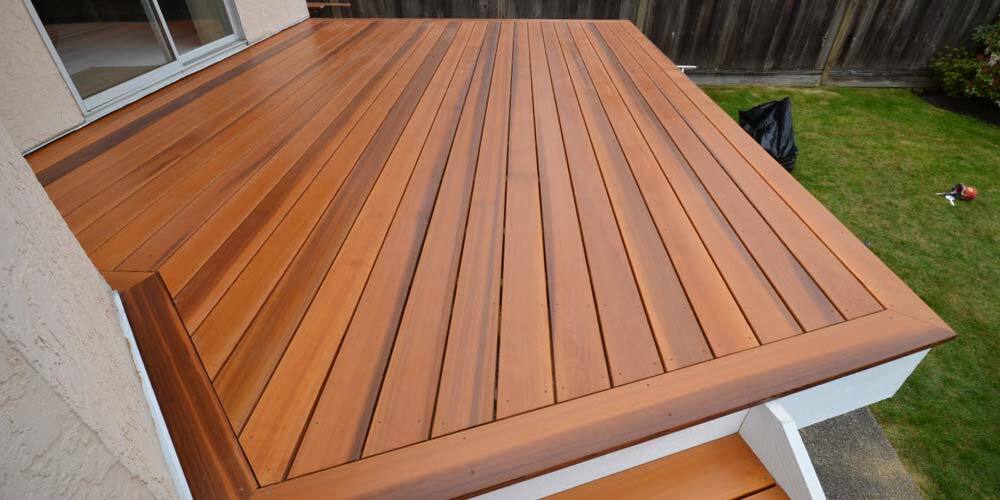
Cedar Decking vs. Composite Decking
Installing a new deck or upgrading an old one can be a very fulfilling prospect. Not only does it beautify your property, but it also increases the value and creates a high return on your investment.
When you want to build a new deck, the first thing is to choose a decking material. The decking material you select will be contingent on your needs, taste, and budget.
Cedar and composite materials are the most common decking materials. Most homeowners are usually at a loss at which of these two great materials they should use.
But first…
What is Cedar Decking?
Cedar Decking is the perfect choice for homeowners interested in a natural look. Made from natural and sustainable resources, cedar wood decking has been hailed for its natural resistance to decay and aesthetic appeal.
What is Composite Decking?
Composite decking combines wood chips (sawdust), plastic, and binding agents. They’re man-made and designed to be stronger and last longer than regular wood materials.
For so long, cedar wood decking has been touted as the leader of decking materials. However, a new competitor has just arrived in Timberland, and they’re looking to boot out the Cedar king.
While they’re both excellent choices, they excel in different areas. Let’s look at some of the factors you need to consider before selecting between cedar and composite decking.
1. Environmental Impact
As the world becomes greener, more people are getting concerned about their carbon footprint and how they can significantly reduce the impact they have on the environment. Hence, there is a need for sustainable and environmentally-friendly decking materials.
Cedar decking materials are natural, organic, and renewable. Cedar materials have a much lower carbon footprint than composite materials, which are processed to look like real wood.
Composite decking, on the other hand, doesn’t decompose easily, and its production process involves the release of greenhouse gases into the atmosphere. There’s the argument that cedar wood production involves cutting down trees, but because it is a renewable resource, it is more sustainable than composite materials.
2. Maintenance
Granted, there is no such thing as a maintenance-free deck. However, some materials require more maintenance than others. Regardless of which decking material you choose, you would still need to carry out some form of maintenance on your deck.
Although they’re easy to maintain, cedar decks require more maintenance than their composite counterparts. One of the major disadvantages of a cedar deck is that it loses its natural color after some time. You can easily combat this by staining your deck from time to time. Also, they can get scratched easily because cedar is a soft wood.
Composite decking, on the other hand, is specifically designed to maintain its appearance for a long period. They do not require any form of painting or staining to keep their appearance.
However, in the event of damage, replacing or repairing cedar decks is easier than composite decking. This is because the production of your particular design might have been discontinued. You might have to settle for a replacement that stands out or resort to changing the entire deck.
3. Design
One of the main reasons people build decks is the beautification and the way they make properties come alive. This is why your decking material needs to be aesthetic and reflect your personality.
Styles get outdated constantly, and there’s a need to keep up with ever-changing trends. Cedar decking materials are versatile and can easily be transformed by sanding and staining them. In short, your design options are endless regarding cedar decks; you can change the color and look at any time.
Real cedar comes in different profiles that can create almost any desirable outlook. Plus, they’re lighter and easy to work with.
With composite materials, you’re limited to only the designs that a company has produced. Rest assured, though; there are many options and colors for you.
Composite decking materials are artificially produced from plastic and other materials, so they generally have this synthetic feel and appearance that does appeal to everyone. Although some top-grade composite decking has been designed to look more realistic than ever, nothing beats real wood’s natural and attractive look. These ‘special designs’ also come at a far greater cost.
4. Cost
Your budget will be pivotal in determining which of the two decking materials you should go for.
Composite deck materials are generally more expensive than cedar wood materials. A cedar deck may cost $25-$30 per sq. foot, while a composite deck may go for $30-$45.
It is worth noting that composite decking doesn’t require the additional expense of re-staining or sealing, which is common with cedar decks. However, the lower upfront cost of cedar decks makes them more enticing.
5. Durability
Nobody wants to invest a sizeable amount of money and effort into a deck that doesn’t last. Both composite and cedar decks are known for their longevity.
Cedar decks can last 15-20 years or more, depending on how they’re maintained. They don’t absorb moisture easily and are naturally resistant to decay, rot, or insects.
Composite decks mostly last longer than 30+ years, but they tend to expand and contract, thus leading to cracking. Also, hollow composite decks -which are cheaper- absorb water easily, thus causing them to warp.
Conclusion
Ultimately, the better option between a cedar and a composite deck really boils down to your needs and situation. If you’re unsure which one to choose, you can talk to the professionals at Longhouse Forest Products.
Our years of experience have made us one of the leading suppliers of timber and other furniture materials on Vancouver Island. To place an order and learn more about our products and services, contact us: 1-800-811-2010 or info@longhousecedar.com.
